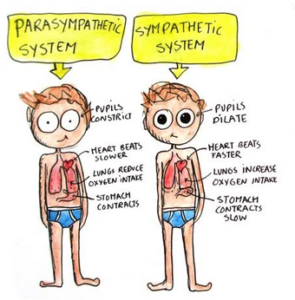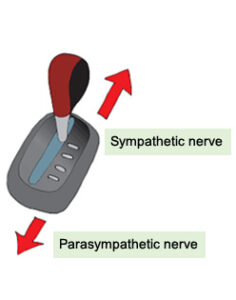
This was originally posted in May 2019 by Judy Petrushka, LCSW, SEP, CDVP. Judy died of ovarian cancer in 2020. She was a fabulous trauma therapist with additional expertise in treating issues of domestic violence. In addition to being a kind and gentle person, Judy was an amazing baker who loved to bring fresh-baked treats to the office. Her clients and all of us at LCW still miss her.
When depression and anxiety team up, you can feel stuck. For some people, the experience may be a sense of ping-ponging. That is, first they have the racing heart, racing thoughts, fear, and possibly panic attacks of anxiety. Then they experience the pervasive shut down, low energy, numbness, sleepiness, and even dissociation of depression.
For others depression and anxiety teaming up may feel as if both are happening at the same time. That is like driving a car with one foot on the gas while simultaneously engaging the emergency brake. Imagine the strain this would put on your car – at some point the engine will blow! When depression and anxiety team up simultaneously, it’s not good news. It puts you at risk for heart disease, asthma, chronic pain, irritable bowl syndrome, autoimmune diseases, and migraines, just to name a few.
To effectively address depression and anxiety teaming up on you, it’s helpful to understand your physiology.
It’s Not All In Your Head: Autonomic Nervous System Division

Through my training in Somatic Experiencing, I have been learning about the human nervous system. I now understand anxiety and depression in a new way. The trouble is not in your head, it’s in your nervous system. Specifically, the autonomic nervous system.
The autonomic nervous system controls a majority of your internal processes automatically, without any conscious control on your part. For example, the autonomic nervous system manages blood pressure, heart and breathing rate, body temperature, digestion, and metabolism. Through its two sub-systems, the sympathetic and parasympathetic systems, the autonomic nervous system manages it all.
The autonomic nervous system’s “master switch” and controller is the hypothalamus in your brain. The hypothalamus monitors information about your internal and external world. Then it responds by activating/stimulating parts of your body (sympathetic system), or reducing/inhibiting them (parasympathetic system). Remember the car analogy from earlier? The sympathetic nervous system is the gas, the parasympathetic nervous system is the brake.
Related Reading: Why Understanding What Trauma Does to the Brain Helps You Heal
What Does the Sympathetic Nervous System Do?

As a mammal, you are designed to fight or flee when a threat presents itself. An animal in the wild, for example, responds to a predator by fleeing or, if necessary, fighting for survival. You respond to a threat similarly. However, your flight might be leaving the room and your fight might be a verbal one.
The sympathetic nervous system prepares your body to handle a stressful or dangerous situation.
This system wants you to get away or win that fight! It increases your heart rate and widens (dilates) your airways to make it easier to breath. It also increases your muscular strength and releases stored energy in preparation for fighting or fleeing. Additionally, it slows body processes that are less important for survival, such as digestion and urination. Using the car analogy, the sympathetic nervous system presses the accelerator.
When you have anxiety, your sympathetic nervous system essentially is stuck in the “on” position.
What is the Parasympathetic Nervous System?
After escaping the danger, a little panting or shaking activate the parasympathetic nervous system to reduce heart rate and breath (foot on the brake), bringing them back to a baseline resting state. If the animal is unable to escape, the freeze response comes on line (engage the emergency brake!) and the animal will shut down.
In shut down mode, all systems go into an energy conservation mode, with heart rate and breathing becoming almost imperceptible. The animal appears dead in hopes that the predator will lose interest or come back later to eat. This gives the animal a chance to jump up and run away. If all else fails, the freeze response also numbs the pain of being eaten by the predator.
You may not be a predator’s lunch, but this system works in you the same way.
The parasympathetic nervous system conserves and restores.
The parasympathetic nervous system slows heart rate, decreases blood pressure, and stimulates the digestive tract to process food and eliminate wastes. This system is active when you are not in danger, but also can respond when you are. Again using the car analogy, the parasympathetic nervous system is the braking system.
When you have depression, your parasympathetic nervous system essentially is stuck in the “on” position.
When depression and anxiety team up on you, those two systems are imbalanced. They may be getting stuck in the “on” position alternately or at the same time.
Autonomic Nervous System Definition = Automatic
In our industrialized society and modern culture, physically fleeing or fighting isn’t always possible. We too often are unable to discharge the adrenaline and cortisol created to help us escape a perceived threat. So we often don’t come back to baseline.
When you can’t come down from a state of high anxiety and stress, that other part of your nervous system is activated to freeze and numb the pain. This survival physiology is meant for life-threatening situations. However, the nervous systems of many of us experience even daily stressors as life-threatening. You may be in survival mode more than is necessary or healthy. And your body wasn’t designed to physically handle this chronic fear and stress.
Unfortunately, you don’t get to choose if you are in survival mode or which defensive response to use. This is by evolutionary design. It all part of the autonomic nervous system. It activates and deactivates automatically. When you experience a life-threatening situation, you don’t have time to pick which threat response you need to use. If a bear is chasing you, you have to act fast!
Related Reading: Can Childhood Trauma Cause Anxiety? Yes, Here’s How
Your Nervous System Really Isn’t So Simple
Until recently, the scientific community viewed the autonomic nervous system as a two-part system. The polyvagal theory changed that view by proposing a three-part system. Stephen Porges, formerly of the University of Chicago and now of the University of North Carolina, developed the Polyvagal Theory from his research on the vagus nerve. He identified that mammals (including humans) actually have two braking systems in their parasympathetic nervous system. These two vagus nerve-driven systems are the dorsal vagal and ventral vagal systems.
Dorsal Vagal Complex:
The dorsal branch of the vagus nerve is present at birth. This branch involves the part of the vagus nerve below the respiratory diaphragm. It is a primitive system that acts like the emergency brake on your car. When the dorsal branch of your vagus nerve activates due to a perceived life threat, a shutdown process occurs. You may feel fatigued, experience difficulty in communicating or accessing emotion, or feel lightheaded. Your digestive system stops its work. If you’ve ever seen a baby fall to sleep after too much stimulation, you’ve seen the dorsal vagal system at work.
If the shutdown process is extreme, it can have an immobility or dissociative effect. Dissociation is when you psychologically separate from your current situations, temporarily escaping distressing experiences, emotions, sensations and thoughts. Immobility shuts the system down in an extreme way, like when prey animals play dead.
If you have chronic depression, it’s likely that the dorsal vagal system has become your nervous system’s primary response to stress. Not only is that stress response inefficient, it’s very taxing on your body, as you’ll see below.
Ventral Vagal System:
The ventral branch of the vagus nerve develops in the first years of life through interaction with caregivers. It involves the part of the vagus nerve above the respiratory diaphragm. The ventral vagal system is primarily a social engagement system that involves a mix of activation and calming. When we engage with other mammals (e.g. loved ones, pets, etc.) in a situation of safety, it slows our system. Think of the last time you were anxious or fearful. Did you go to another person for a hug or reassurance or cuddle with your pet? You were using your ventral vagal braking system.
Again, using a car analogy, when the ventral vagal system is activated, it is like the act of defensive driving and using the brake pedal. You turn the wheel, adjust the speed, and use your brake pedal based on the road or presence of other cars. So the ventral vagus system allows parasympathetic activation in a nuanced way, offering a gentler “braking” quality than the heavy-handed dorsal vagal shutdown.
The ventral vagal system also is hundreds of times faster than the dorsal vagal system. When the dorsal vagal system activates, it initiates a slew of chemical reactions in the body. But it can take up to 20 minutes or more to rid the body of those chemicals and return to our pre-fight or flight state! The ventral vagal system does not involve these same chemical reactions. Instead, it dampens the activated nervous system through subtle back and forth shifts. This results in quicker, more efficient, and more gentle “braking”.”
Just like the human brain is not fully developed when we are born, the ventral vagal brake develops as we grow. Access to this gentle brake can get derailed if we don’t have the kind of nurturing experiences when we are little that let us feel safe and protected by our caregivers. If you have chronic anxiety, this may be part of the reason why.
What Are Adverse Childhood Experiences (ACEs)
We now know because of the groundbreaking Adverse Childhood Experiences or ACE Study that early childhood abuse and neglect, as well as other household challenges and trauma, are positively correlated to behavioral and health issues later in life. The more exposure you had to adverse experiences as a child, the higher your risk. You can find your ACE score by taking this the ACE questionnaire.
Kathy L. Kain and Stephen J. Terrel write in their book, Nurturing Resilience, that the outcome of the ACE Study revealed 5 main discoveries:
- ACEs are common. Nearly two thirds of adults report at least one.
- They cause adult onset of chronic disease, such as cancer, and heart disease, as well as mental illness, violence and being a victim of violence.
- ACEs don’t occur alone. If you have one, there’s an 87% chance that you have two or more.
- The more ACEs you have, the greater the risk of chronic disease, mental illness, violence and being a victim of violence
- ACEs are responsible for a significant share of workplace absenteeism, and costs for health care, emergency response, mental health and criminal justice. So, the fifth finding from the ACE study is that childhood adversity contributes to most of our major chronic health, mental health, economic health, and social health issues. (ACEs Too High 2017).
Related Reading: Why Does Childhood Trauma Affect Adulthood?
What If I Didn’t Have Childhood Trauma?

You may be one of the lucky ones who did not experience any ACEs or trauma as a child. But what if that was the case and you are still suffering from the teaming up of depression and anxiety? You may be surprised to learn there are other experiences that can throw off our nervous system and our ability to come back to a baseline resting state. Irene Lyon, MSC, SEP from Vancouver, Washington offers on-line courses, workshops and has excellent free resources on YouTube and her website.
In a recent blog post, she identified some common human experiences that can be traumatic, but are often seen as not. Below is a summary of some of these. Click here to link to the original post for the complete list and expanded descriptions:
- Near-Death Experiences (NDEs) – Choking, near drowning, high fever, serious infections and viruses, being in a coma, high fever, anything that puts a human being’s physiology into a state of preparedness for dying and death.
- Surgery and Anesthesia – These can induce a strong traumatic memory in the nervous system due to an incomplete urge to flee. This is common in children who have tonsillectomies, for example. Also waking up while under anesthesia or going into surgery in a high fear state can be traumatic. Peter Levine discusses this in his book Waking the Tiger.
- Premature Birth and or Highly Traumatic Birth – We now know that little ones feel EVERYTHING and still log the experiences they are having in their nervous system, organ systems, and in their somatic (body) self. Additionally, separating mother and baby because of medical issues can compromise their bond.
- In Utero Stress – Mothers who are in high stress while pregnant and or living in and around unsafe conditions (war, and abusive partner etc.) will pass along their stress chemicals to the baby in utero.
- Intergenerational Trauma – Epigenetic research shows that trauma gets passed on to not only the next generation, but to multiple generations. We keep and express the trauma of our ancestors if we do not consciously and actively heal it from a nervous system and neurobiological level.
- The Need to be “Perfect” (and Perform for Love and Attention) – The demand placed on children to try to force them to be what we wish them to be (whether they want to or not) is incredibly toxic and harmful. Unfortunately, this often gets missed because this kind of behavior often raises human beings who are incredibly skillful and disciplined in their fields.
Trauma that comes from these types of stressors can create imbalances in your autonomic nervous system similar to those from ACEs. These imbalances not only allow depression and anxiety to team up, but can also set the stage for other mental and physical health conditions.
What You Can Do If Depression and Anxiety are Teaming Up
I am grateful for tools and interventions that, as Peter Levine, the developer of Somatic Experiencing says, allow us to move from “fixity to flow.” One of the premises of Somatic Experiencing is that the body knows what to do when it has access to the conditions for nervous system regulation. One of these conditions can be support.
With support you can build capacity to handle activation and to improve regulation of your nervous system. As capacity grows, you can experience stressors without going into our survival physiology. You can begin to feel safe in your body and in your relationships. Your mental and physical health improves. And you can gain access to the to gentle braking system that enables you to no longer have depression and anxiety team up on you.
The stuff that keeps you feeling stuck is not in your head – it is in your nervous system. Relief is available. If you would like to ask questions or get connected to a Somatic Experiencing practitioner, contact us today. We have offices in Glen Ellyn , the Jefferson Park neighborhood in Chicago, and Sycamore.




